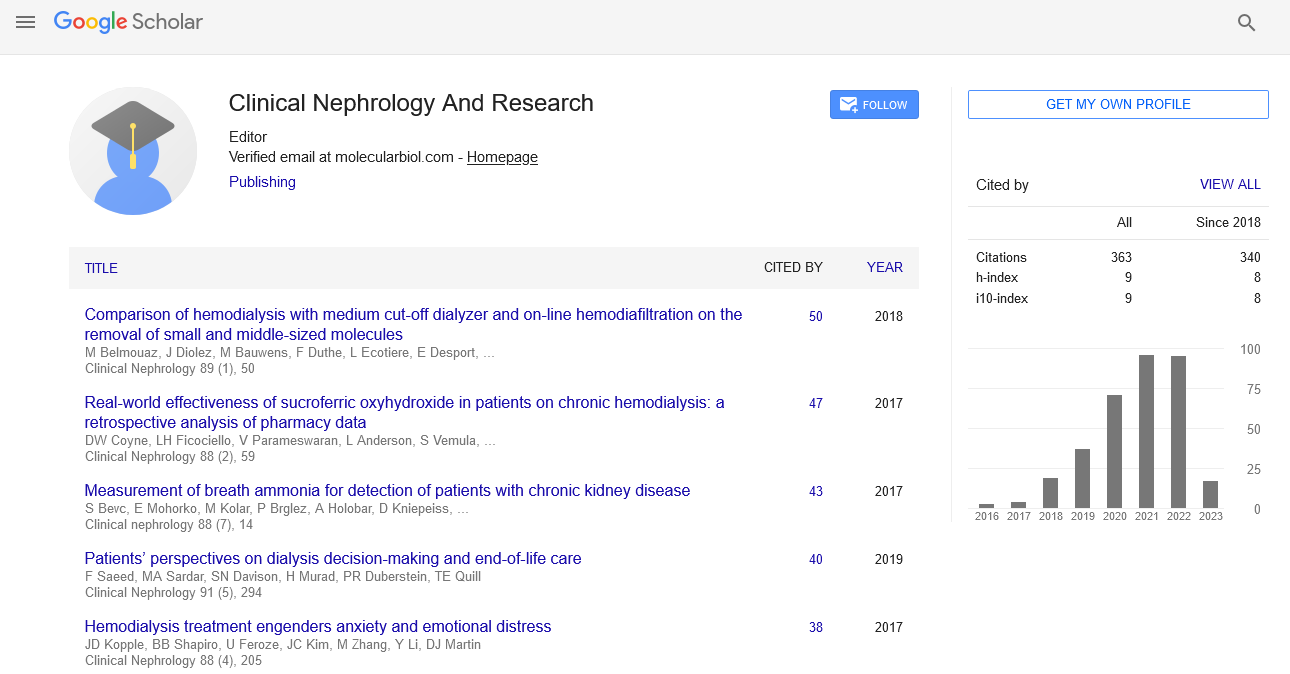
Sign up for email alert when new content gets added: Sign up
Simultaneous Bilateral Endoscopic Surgery (SBES) for patients with bilateral upper tract Urolithiasis
5th International Conference on Urology and Renal Health
October 25, 2022 | Webinar
Karian Trujillo Rios
Hospital Puerta de Hierro Colima, Mexico
Posters & Accepted Abstracts: Clin Nephrol Res
Abstract :
Urolithiasis is a common health disorder in the Western World with a lifetime risk of stone formation as high as 10– 12% in males and 6–8% in females, and the prevalence of stone disease is on the rise over the past two decades. Similarly, also the incidence of bilateral renal stones is not negligible—recent studies have shown that up to 15% of patients with urolithiasis will have bilateral renal stones. It has been demonstrated that bilateral same-session endourological procedures for stones are effective in terms of both efficacy (i.e., Stone-Free Rate or SFR) and safety. Moreover, same-session bilateral procedures for nephrolithiasis are associated with several advantages, including single anesthetic exposure for the patient, shorter cumulative hospitalization time, fewer days out of work, decreased patient radiation exposure, and greater overall cost effectiveness. Historically, same-session bilateral procedures have been performed by the surgeon first completing the treatment on one side and then completing the treatment on the other side—that is, treating the stones in the right ureter and/or kidney first, and then proceeding with treatment of the left ureter and/or kidney or vice versa. However, a potentially more efficient treatment option is Simultaneous Bilateral Endoscopic Surgery (SBES), which entails at least two surgeons working simultaneously, each treating one kidney or ureter as opposed to treating one kidney after the other. Potential advantages would include improvements in efficiency—treatment of both renal units with shorter anesthetic time and also a decrease in the total number of procedures that a given patient may require. The procedure is then started by the ureteroscopic surgeon: through a flexible cystoscope, a guidewire is placed into the renal pelvis of the kidney in which PCNL is performed. A ureteral occlusion balloon is subsequently placed and positioned after retrograde pyelography. At this point, the ureteroscopic surgeon can begin the fURS procedure on the contralateral side, while the PCNL surgeon will begin the PCNL. The surgeons work simultaneously during the procedure and the fluoroscopic c-arm is shared by the two surgeons—each using the c-arm when needed. PCNL approach during SBES. PCNL is performed using 24 Fr or 17.5 Fr percutaneous tract, a rigid nephroscope and either ultrasonic/pneumatic lithotripsy or holmium laser lithotripsy, and basket extraction. Dilatation of the tract is performed using either a balloon or metallic dilatator. At the end of every PCNL procedure, flexible nephroscopy is performed in addition to fluoroscopic evaluation to ensure that all stones have been removed. A double-J stent is left for drainage at the end of each PCNL. Successful performance of SBES should in theory magnify the advantages of same-session bilateral surgery, as both procedures can be accomplished at the same time (i.e., one kidney does not have to wait until the other is stone free),further shortening operative and anesthetic times. Recently, reports have described the SBES approach to both kidneys for the treatment of renal calculi, showing favorable outcomes in terms of SFR and complication rates without an increased risk of the development of acute renal failure or other complications. Ideal candidates to SBES are patients bearing bilateral small- to medium-size stones who have a high chance to become stone free and, as a consequence, are unlikely to undergo a second surgery. It is noteworthy that SBES requires a special OR setup, a complete endourological armamentarium, and dedicated nurses in order to allow both surgeons to work simultaneously and efficiently. Specialized equipment includes two endoscopic towers (one for each surgeon to view the kidney that each is operating on) There are several potential advantages to performing SBES in lieu of staged procedures or even same-session bilateral procedures. Most importantly, anesthesia time may be decreased significantly by having both renal units operated on at the same time. In addition, shorter operative time may limit the decrease in core body temperature that is seen during endourological surgery when abundant irrigation is used. This may, in turn, decrease the risk of postoperative shivering and prolong recovery time due to hypothermia. Moreover, SBES reduces the overall operative time com- pared with a single-session bilateral procedure and/ or staged surgeries. In recent years, same-session bilateral endoscopic surgery has been shown to be safe and effective, for both fURS and PCNL procedures. Potential advantages of same-session surgery include less anesthetic exposure for the patient as well as the need for fewer procedures to achieve stone clearance.




